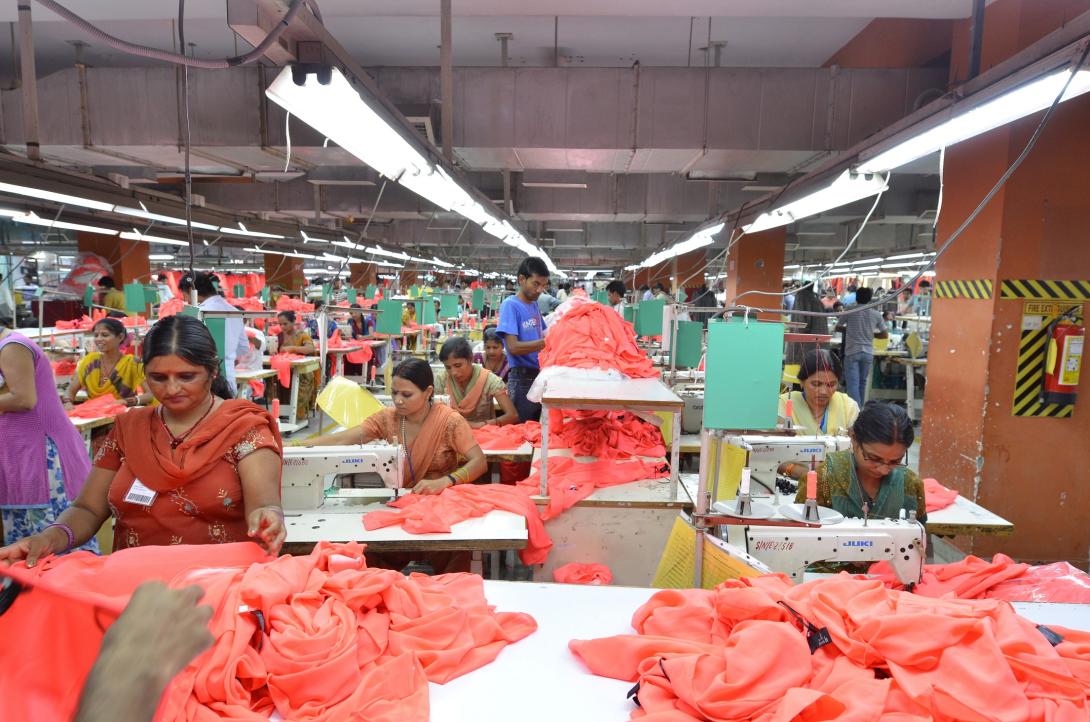Environment Friendly Techniques for Textiles Industries

© GIZ, Textiles India
The overall objective is to use environment friendly technologies and techniques is promoted in selected industry sectors, particularly from small and medium enterprises (SMEs). Pilot activities were taken up in textile industries in Gujarat with positive results.
Main features and components
There are various environmental issues concerning the textiles industry. The most obvious ones are resource consumption, e.g. water and energy, and environmental pollution such as due to wastewater generation and atmospheric emissions. The high consumption of water is characteristic for the textiles industry. Water is used in various processes of fabrication until colouring and finishing of the final product. These processes are also directly related to the use of high doses of chemicals, e.g. dying processes. Moreover, the high thermal energy input, inefficient processes and machinery as well as missing recovery systems lead to intensive energy consumption with potential negative impacts on the environment.
The mapping of core issues and potential solutions are the main features of this tool. The following core environmental issues were identified:
- Issue 1: Less efficient electrical equipment
- Issue 2: Inefficient water recovery & reuse
- Issue 3: Waste water generated from various washing sections
- Issue 4: Management of chemical usage
- Issue 5: Inefficient boiler operation
- Issue 6: High thermal energy losses through uninsulated areas, improper condensate recovery
- Issue 7: High heat loss through dryer
- Issue 8: Waste due to manual operations
Implementation and work steps
The main steps involved in the demonstration of solutions regarding environmental friendly techniques in textile industry on pilot basis included the following:
- Mapping of core issues
- Consultation on solutions
- Demonstration of pilot measures
- Documentation
- Capacity Building
In order to identify environmental issues, environment friendly techniques and technologies for the textile sector in India, following methodology was adopted:
- Data and information collection, through secondary sources as well as interaction with GCPC, NPC, GPCB, FICCI, CII and other relevant expert organisations.
- Industrial visits (mainly industries in Narol Industrial Area from the sector) to justify and ensure, the relevance with environmental issues identified from secondary sources and requirement of environment friendly techniques and technologies with respect to water usage, chemical usage, energy consumption, effluent / waste water management, raw material and solid waste management.
- Collection of relevant information from UBA/BREF reports, CPCB, NPC etc. on available environmental friendly techniques commercially available and proven for the sector.
The demonstration of pilot measures was done through volunteering industries and this followed documentation and monitoring of the implemented measures. Many successful trainings and brainstorming sessions were organised that helped consolidating the pilots that are useful for the specific industries from Ahmedabad. The University of Applied Sciences of Northwestern Switzerland also helped sharing inputs with the industries on best practices on effluent treatment and resource efficiency.
For the volunteering industries, detailed process analysis (including water and material balance) was carried out to identify the waste streams and related environmental issues. Potential solutions were then explored for the identified environmental issues by referring documents like BREF (Best Available Techniques REFerence) documents from EU, solutions available in the market, cleaner production measures implemented in industries by the Gujarat Cleaner Production Centre (GCPC), International case examples and national/local case examples; and consultation with experts/consultants. The commercially available technologies in the market, as informed by the industries, were looked into.
Output
- Recycle/reuse of cooling water and condensate water as boiler feed water
- Reuse of treated water for washing at printing machines
- Water consumption optimisation at jigger machines
- Caustic soda recovery system
- Caustic batch washing in place of continuous washing in jet
- Replacing of alkaline scouring with bio-scouting enzyme for enzymatic scouring
- Reuse of alkaline stream for mercerising
- Efficient boiler operation
- Optimisation of heat energy in jigger machines
- Low liquor ration jet dyeing machines
- Auto colour dispensing through spectrophotometer and chemical dispensing system
- Heat losses optimisation at cylinder drying range
Useful links
Downloads
Characteristics
Phase of intervention
Designing SIA, Technical infrastructure
Level of intervention
Company, Park management
Regions
Asia
Countries
India
Target groups
Company, SME, Industrial area management and operator, Policy makers
GIZ project
Sustainable environment-friendly industrial production (SEIP II) in India